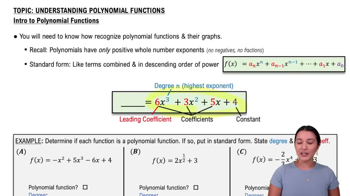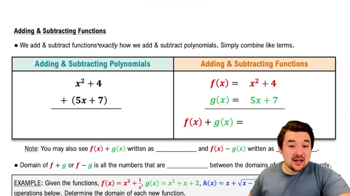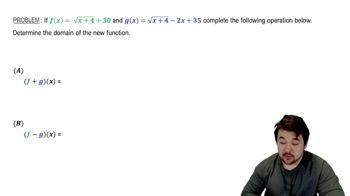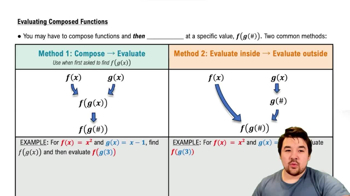Table of contents
- 0. Functions7h 52m
- Introduction to Functions16m
- Piecewise Functions10m
- Properties of Functions9m
- Common Functions1h 8m
- Transformations5m
- Combining Functions27m
- Exponent rules32m
- Exponential Functions28m
- Logarithmic Functions24m
- Properties of Logarithms34m
- Exponential & Logarithmic Equations35m
- Introduction to Trigonometric Functions38m
- Graphs of Trigonometric Functions44m
- Trigonometric Identities47m
- Inverse Trigonometric Functions48m
- 1. Limits and Continuity2h 2m
- 2. Intro to Derivatives1h 33m
- 3. Techniques of Differentiation3h 18m
- 4. Applications of Derivatives2h 38m
- 5. Graphical Applications of Derivatives6h 2m
- 6. Derivatives of Inverse, Exponential, & Logarithmic Functions2h 37m
- 7. Antiderivatives & Indefinite Integrals1h 26m
- 8. Definite Integrals4h 44m
- 9. Graphical Applications of Integrals2h 27m
- 10. Physics Applications of Integrals 2h 22m
0. Functions
Combining Functions
Problem 4.8.58b
Textbook Question
{Use of Tech} Fixed points of quadratics and quartics Let f(x) = ax(1 -x), where a is a real number and 0 ≤ a ≤ 1. Recall that the fixed point of a function is a value of x such that f(x) = x (Exercises 48–51).
b. Consider the polynomial g(x) = f(f(x)). Write g in terms of a and powers of x. What is its degree?
 Verified step by step guidance
Verified step by step guidance1
First, understand that a fixed point of a function f(x) is a value x such that f(x) = x. For the function f(x) = ax(1 - x), we need to find f(f(x)) to form the polynomial g(x).
Start by substituting f(x) into itself: f(f(x)) = a(f(x))(1 - f(x)). This means we need to substitute f(x) = ax(1 - x) into the expression again.
Calculate f(x) = ax(1 - x) and substitute it into the expression: f(f(x)) = a(ax(1 - x))(1 - ax(1 - x)).
Simplify the expression: Expand the terms inside the parentheses and multiply them out. This will involve expanding (1 - ax(1 - x)) and multiplying it by ax(1 - x).
Determine the degree of the polynomial g(x): After simplifying, observe the highest power of x in the expression. The degree of g(x) will be the highest power of x present in the expanded form.
 Verified video answer for a similar problem:
Verified video answer for a similar problem:This video solution was recommended by our tutors as helpful for the problem above
Video duration:
4mPlay a video:
Was this helpful?
Key Concepts
Here are the essential concepts you must grasp in order to answer the question correctly.
Fixed Points
A fixed point of a function is a value of x for which the function evaluates to the same value, meaning f(x) = x. This concept is crucial in understanding the behavior of functions, particularly in iterative processes and stability analysis. In the context of the given function f(x) = ax(1 - x), finding fixed points involves solving the equation ax(1 - x) = x.
Recommended video:

Critical Points
Composition of Functions
The composition of functions involves applying one function to the result of another. In this case, g(x) = f(f(x)) means we first apply f to x, and then apply f again to the result. Understanding function composition is essential for manipulating and simplifying expressions, especially when dealing with polynomials and their degrees.
Recommended video:

Evaluate Composite Functions - Special Cases
Degree of a Polynomial
The degree of a polynomial is the highest power of the variable in the polynomial expression. It provides insight into the polynomial's behavior, such as the number of roots and the end behavior of the graph. For the polynomial g(x) derived from f(f(x)), determining its degree involves analyzing the composition and identifying the maximum exponent of x in the resulting expression.
Recommended video:

Introduction to Polynomial Functions

 5:56m
5:56mWatch next
Master Adding & Subtracting Functions with a bite sized video explanation from Nick
Start learning




